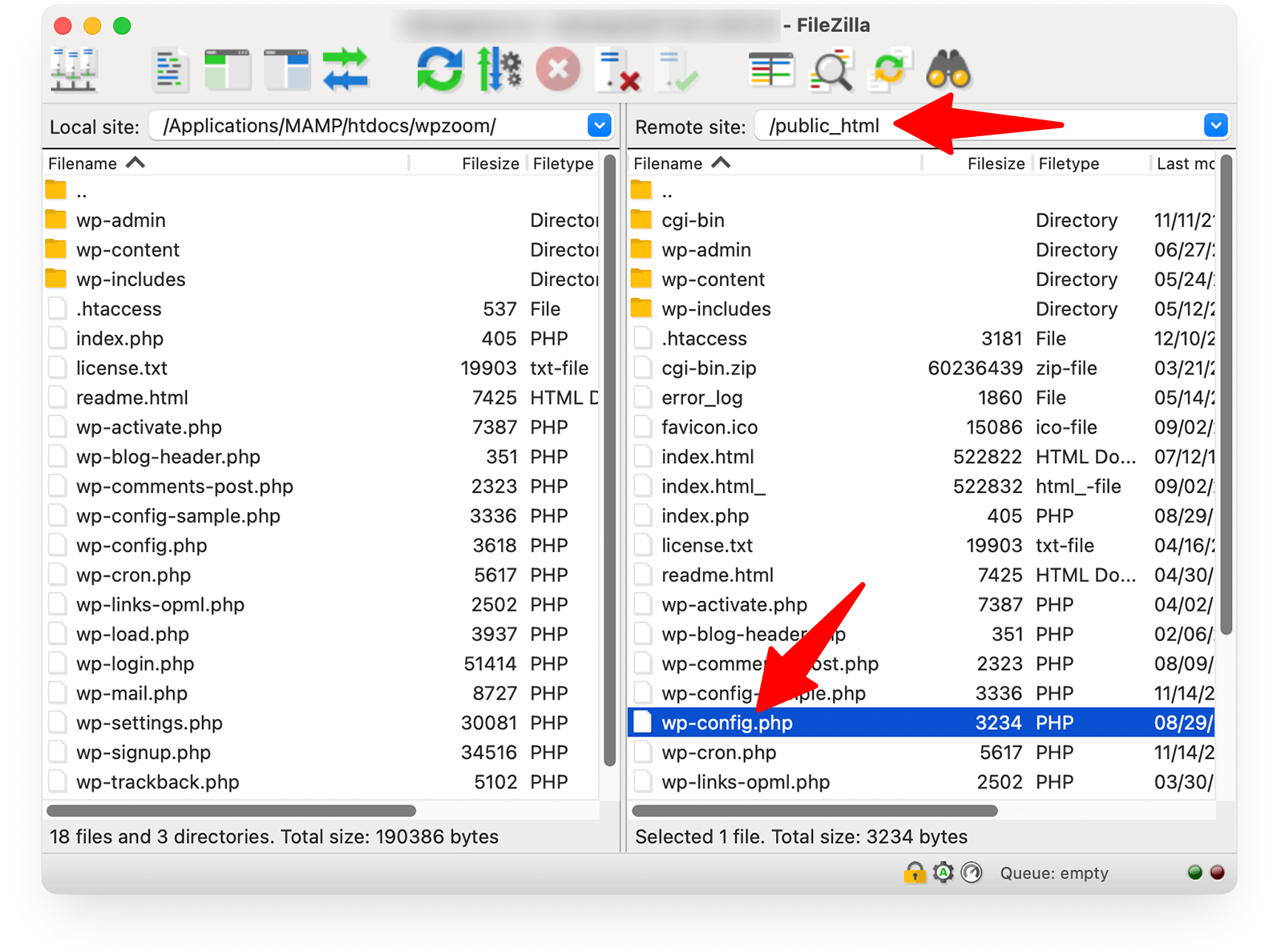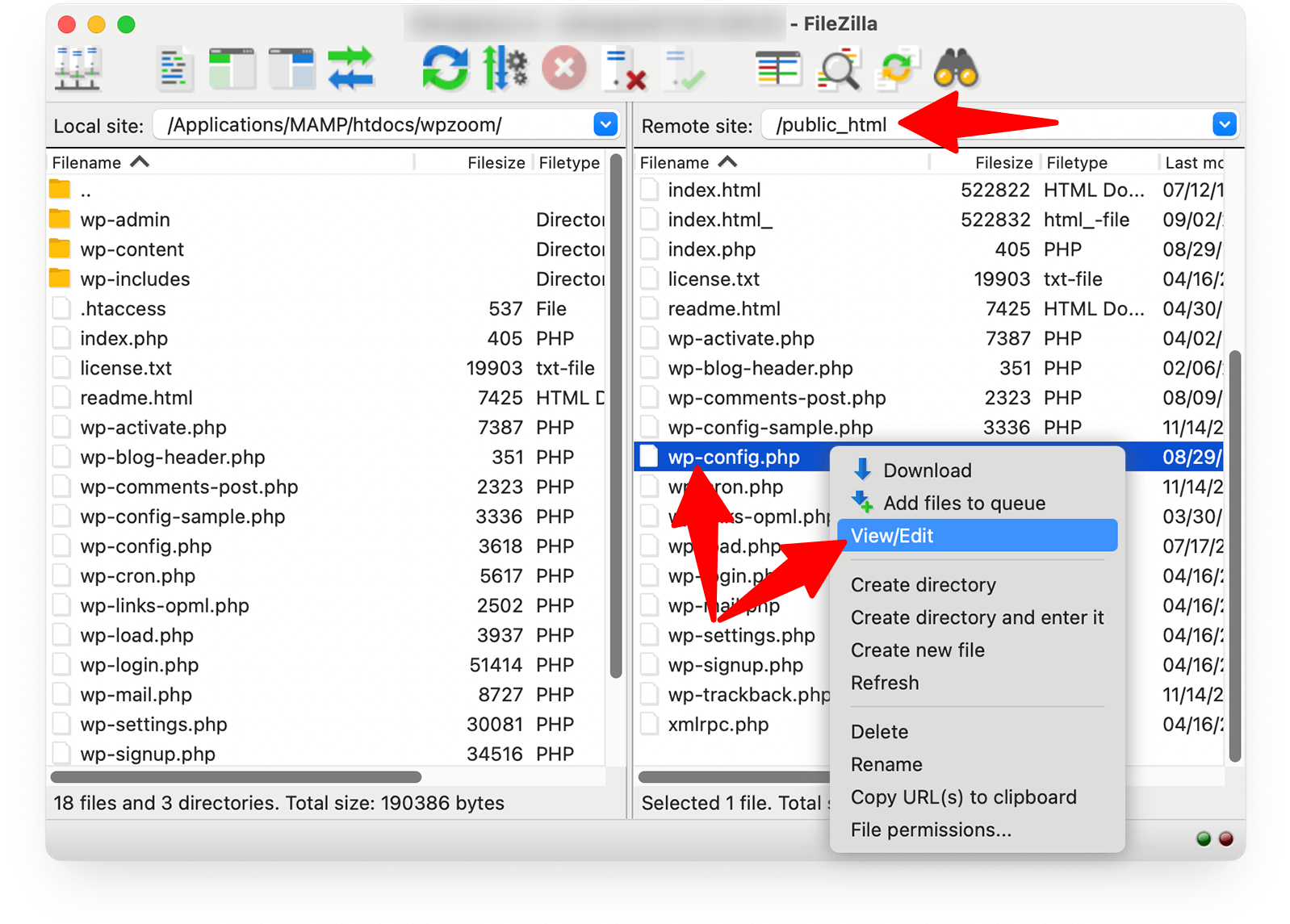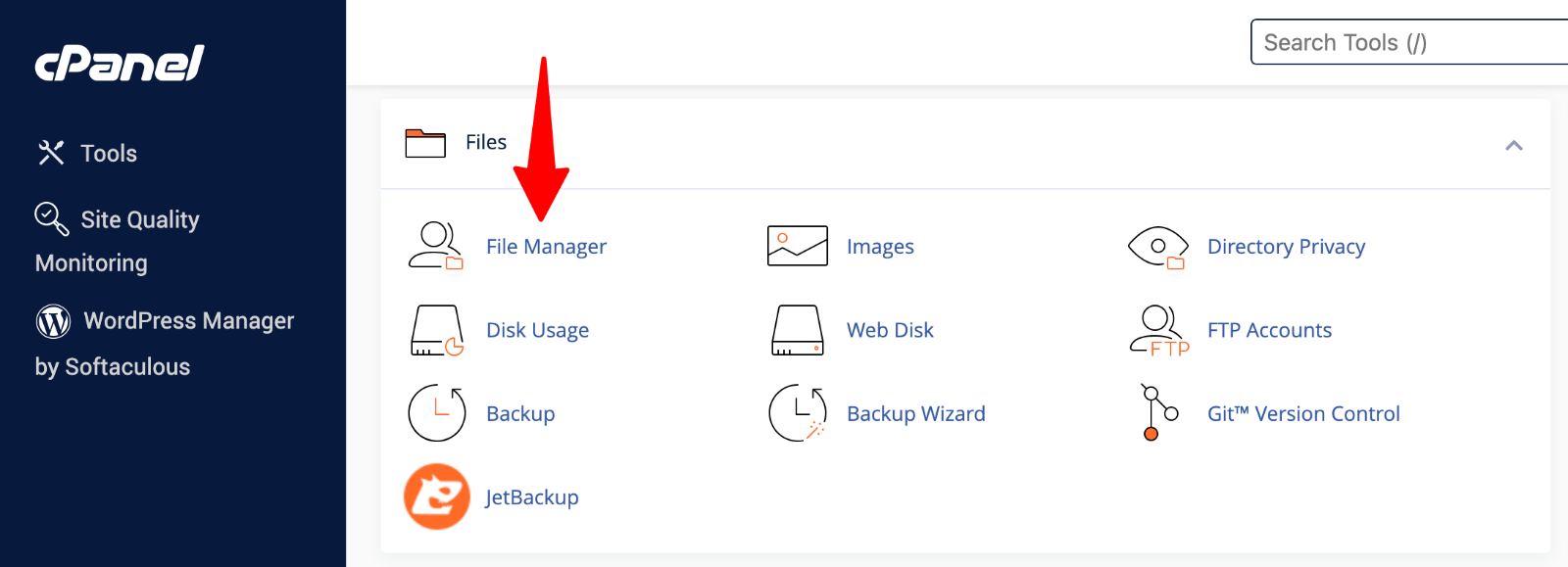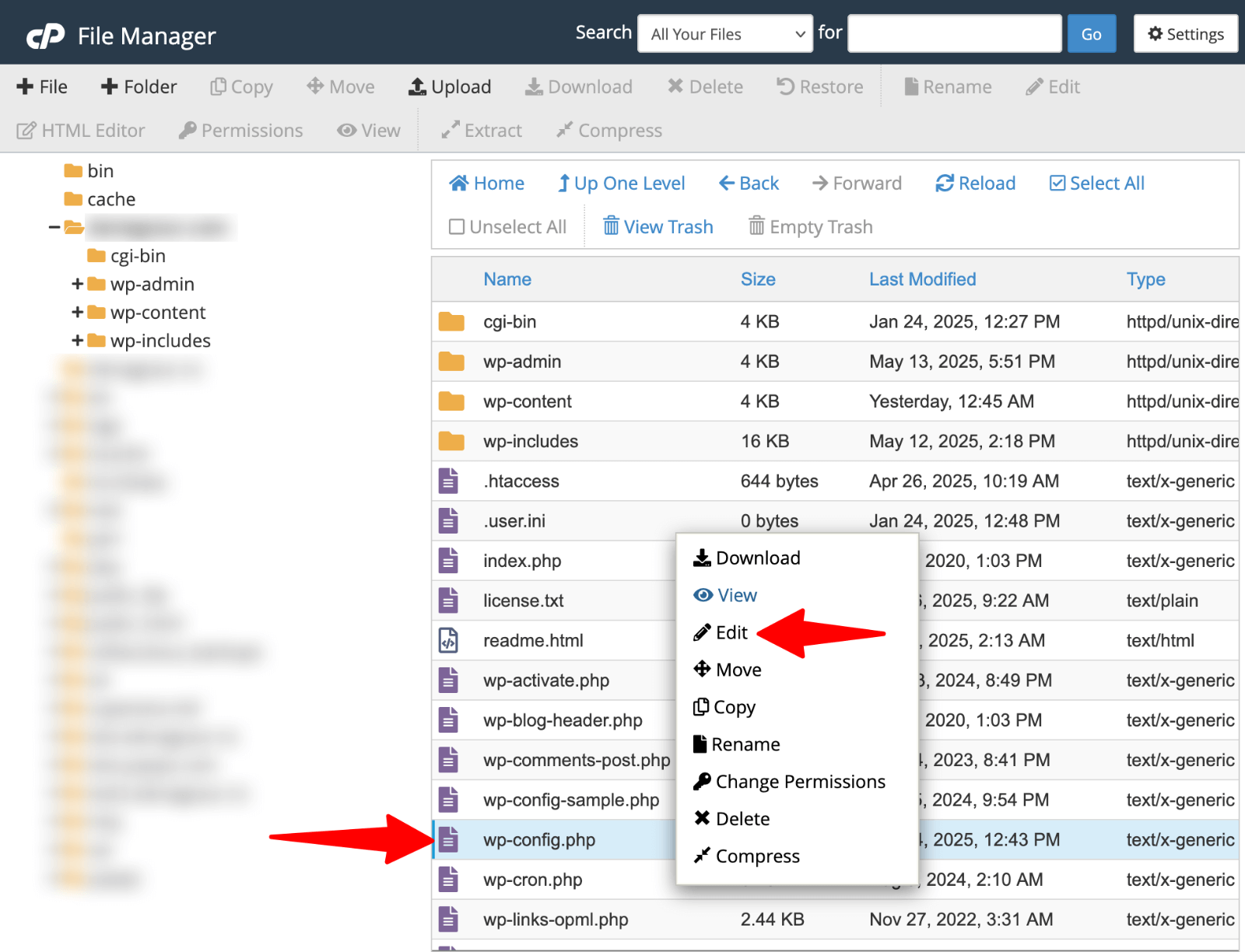Most WordPress customers by no means notice they’ve entry to a strong management panel that manages their web site’s core performance. The wp-config.php file provides you direct management over database settings, safety measures, and efficiency optimizations that internet hosting firms usually deal with for you.
Studying to work with this file transforms you from somebody who is determined by others right into a assured web site administrator. We’ll present you the best way to find, modify, and defend this important WordPress configuration file.
Desk of Contents
- What is wp-config.php?
- wp-config.php Location in WordPress
- Understanding the wp-config.php Structure
- Editing wp-config.php: Step-by-Step Guide
- Essential wp-config.php Tweaks
- Advanced wp-config.php Configurations
- Common wp-config.php Errors and Troubleshooting
- Best Practices and Security Tips
What’s wp-config.php?
The wp-config.php file is a core configuration file in WordPress that shops database credentials, authentication keys, and important settings. It connects WordPress to the MySQL database and defines site-specific variables comparable to desk prefix and debugging choices.
While you first install WordPress, this file will get created routinely. It shops important info like your database identify, username, password, and host particulars. With out these credentials, WordPress can’t entry the saved content material, person info, or settings that make your web site perform.

Past database connections, wp-config.php handles safety by way of authentication keys and salts. These randomly generated strings encrypt person cookies and strengthen your site against attacks. The file additionally manages debugging modes, reminiscence limits, and file paths.
Whereas most customers hardly ever must edit it instantly, understanding its construction provides you extra management over your web site’s conduct and efficiency.
wp-config.php Location in WordPress
This crucial file lives in your WordPress set up’s root listing, which is often named public_html, www, or htdocs relying in your internet hosting supplier. You’ll discover wp-config.php sitting alongside different core WordPress information and folders like wp-content, wp-admin, and wp-includes.

The precise wp-config.php location is determined by how WordPress was put in in your server. For normal installations, look in your web site’s predominant listing. Nonetheless, some setups place wp-config.php one stage above the WordPress root listing for enhanced safety. In case you can’t find the file within the anticipated spot, test the mother or father listing earlier than contacting your internet hosting supplier.
You possibly can entry this location by way of a number of strategies. FTP shoppers like FileZilla, WinSCP, or CyberDuck present direct server entry. Join utilizing your internet hosting credentials and navigate to your web site’s root folder. Alternatively, most internet hosting suppliers supply cPanel with a built-in File Supervisor that permits you to browse your information by way of an internet interface with out separate software program.
For local WordPress installations utilizing XAMPP, WAMP, or comparable instruments, wp-config.php is positioned within the htdocs folder of your native WordPress listing.
In case you manually set up WordPress, you gained’t initially discover wp-config.php on this location. As a substitute, you’ll see a file referred to as wp-config-sample.php. This pattern file serves as a template containing all the required construction with placeholder values. Throughout guide set up, you’ll must create wp-config.php by both letting the WordPress installer generate it (in case your server permissions permit) or by copying wp-config-sample.php, renaming it to wp-config.php, and filling in your database particulars.
Understanding the wp-config.php Construction
Opening wp-config.php reveals a number of distinct sections, every serving a selected objective. Let’s study these parts to know their roles.
MySQL Settings
The primary main part incorporates your database connection particulars:
outline( 'DB_NAME', 'your_database_name' );
outline( 'DB_USER', 'your_username' );
outline( 'DB_PASSWORD', 'your_password' );
outline( 'DB_HOST', 'localhost' );
outline( 'DB_CHARSET', 'utf8' );
outline( 'DB_COLLATE', '' );Every fixed serves a selected perform:
- DB_NAME identifies your database
- DB_USER and DB_PASSWORD present login credentials
- DB_HOST usually stays ‘localhost’ except your host makes use of a unique server
- The charset and collation settings decide how WordPress shops and types textual content
Authentication Keys and Salts
WordPress safety depends closely on eight distinctive authentication keys and salts that encrypt delicate info saved in person cookies. These random strings add an additional safety layer that makes it extraordinarily tough for malicious actors to intercept or manipulate person periods:
outline( 'AUTH_KEY', 'your_unique_phrase_here' );
outline( 'SECURE_AUTH_KEY', 'your_unique_phrase_here' );
outline( 'LOGGED_IN_KEY', 'your_unique_phrase_here' );
outline( 'NONCE_KEY', 'your_unique_phrase_here' );Every key serves a selected objective in WordPress’s safety structure:
- AUTH_KEY validates authentication cookies
- SECURE_AUTH_KEY handles SSL connections
- LOGGED_IN_KEY manages logged-in person periods
- NONCE_KEY protects in opposition to CSRF assaults.
The corresponding salt values add further randomness to the encryption course of.
Database Desk Prefix
The desk prefix determines how WordPress names its database tables:
$table_prefix = 'wp_';Altering this from the default ‘wp_’ provides a layer of safety by making your database construction much less predictable to attackers.
Debugging Configuration
Close to the underside, you’ll discover the debug setting:
outline( 'WP_DEBUG', false );This controls whether or not WordPress shows errors and warnings, which helps throughout improvement however ought to keep disabled on dwell websites.
Absolute Path Definition
The ultimate part establishes WordPress’s absolute path and hundreds the core WordPress information.
if ( ! outlined( 'ABSPATH' ) ) {
outline( 'ABSPATH', __DIR__ . '/' );
}
require_once ABSPATH . 'wp-settings.php';These traces inform WordPress the place to seek out its core information. Don’t modify this part except you’re completely sure concerning the adjustments.
Enhancing wp-config.php: Step-by-Step Information
One fallacious character can take your web site offline, so preparation issues.
Making a Backup
Begin by downloading the present wp-config.php file by way of FTP or your file supervisor. Reserve it someplace secure in your pc. For full safety, think about using a backup plugin to create a full site backup.
Enhancing through FTP
Utilizing an FTP consumer gives the most secure technique for modifying wp-config.php.
1. Hook up with your server utilizing FileZilla, WinSCP, or your most well-liked FTP software program.
2. Navigate to your WordPress root listing and find the wp-config.php file.
3. Proper-click on wp-config.php and choose “View/Edit” to start out modifying or “Obtain” to avoid wasting a duplicate to your native pc.

4. Open the downloaded file utilizing a plain textual content editor like Notepad++, Elegant Textual content, or Visible Studio Code.
Keep away from utilizing phrase processors like Microsoft Phrase, as they’ll introduce formatting characters that break PHP code.
5. Make your required adjustments to the file, fastidiously sustaining correct PHP syntax.
6. Save the file and add it again to your server utilizing your FTP consumer. When prompted, select to overwrite the prevailing file.
Check your web site instantly after importing to make sure every thing works appropriately.
Enhancing Via cPanel File Supervisor
1. Entry your internet hosting management panel and open the File Supervisor.

2. Find wp-config.php in your root listing.
3. Proper-click and choose “Edit” or “Code Editor“.

4. Make your adjustments instantly within the browser interface. Most file managers embrace syntax highlighting, which helps spot errors.
5. Save your adjustments when completed.
Frequent Errors to Keep away from
Look ahead to these typical errors:
- Utilizing curly quotes as a substitute of straight quotes
- Lacking semicolons at line ends
- Deleting mandatory areas or brackets
- Enhancing beneath the “cease modifying” remark line
- Saving information with the fallacious encoding
At all times check your web site instantly after importing adjustments. If one thing breaks, restore your backup file immediately.
Important wp-config.php Tweaks
Database Connection Settings
Typically it’s good to replace database credentials. Your host may change server particulars, otherwise you may migrate to a brand new supplier. Updating these settings retains your web site related.
To switch database particulars, discover the MySQL settings part. Substitute the placeholder values together with your new info:
outline( 'DB_NAME', 'new_database_name' );
outline( 'DB_USER', 'new_username' );
outline( 'DB_PASSWORD', 'new_password' );Some hosts use non-standard ports or socket connections. In case your database runs on a unique port, append it to the hostname:
outline( 'DB_HOST', 'localhost:3307' );For hosts utilizing Unix sockets, specify the socket path:
outline( 'DB_HOST', 'localhost:/var/run/mysqld/mysqld.sock' );Safety Enhancements
Updating Authentication Keys and Salts
WordPress safety is determined by frequently updating your authentication keys and salts. Generate new keys utilizing WordPress.org’s secret key service and substitute the prevailing values in your wp-config.php file. This course of invalidates all current person periods, forcing everybody to log in once more, a strong safety measure in the event you suspect unauthorized entry.
Altering Desk Prefix
The default ‘wp_‘ desk prefix makes your database a straightforward goal for automated assaults. Select a {custom} prefix that features random characters:
$table_prefix = 'xyz_789_';Do not forget that altering the desk prefix on an current web site requires database modifications. In case you’re comfy with SQL instructions, use a plugin or manually replace your database.
Relocating wp-config.php for Enhanced Safety
Transferring wp-config.php one listing stage above your WordPress set up hides it from direct internet entry. Create a brand new wp-config.php file in your WordPress listing that features the relocated file:
<?php
embrace('/path/to/safe/location/wp-config.php');
?>Proscribing Entry through .htaccess
Add safety guidelines to your .htaccess file to dam direct entry to wp-config.php:
<information wp-config.php>
order permit,deny
deny from all
</information>Debugging and Error Logging
WordPress debugging helps establish plugin conflicts, theme issues, and PHP errors. Allow debugging by setting WP_DEBUG to true:
outline( 'WP_DEBUG', true );For manufacturing websites, log errors with out displaying them to guests:
outline( 'WP_DEBUG', true );
outline( 'WP_DEBUG_LOG', true );
outline( 'WP_DEBUG_DISPLAY', false );
@ini_set( 'display_errors', 0 );This configuration writes errors to a debug.log file in your wp-content listing whereas protecting them hidden from web site guests.
Efficiency Optimization
Adjusting PHP Reminiscence Limits
WordPress websites with quite a few plugins or advanced themes could require increased PHP memory allocation. Set {custom} reminiscence limits to forestall “reminiscence exhausted” errors:
outline( 'WP_MEMORY_LIMIT', '256M' );
outline( 'WP_MAX_MEMORY_LIMIT', '512M' );The primary fixed applies to front-end operations, whereas the second handles admin space duties that usually require extra reminiscence.
Altering the Uploads Listing
Customise your media uploads location for organizational or safety functions:
outline( 'UPLOADS', 'wp-content/media' );This setting creates a brand new uploads listing inside wp-content. In case you’re altering a longtime web site, bear in mind emigrate current media information.
Superior wp-config.php Configurations
These settings cater to builders, system directors, and customers with particular technical necessities.
Controlling WordPress Computerized Updates
WordPress routinely installs minor safety updates by default, however you may customise this conduct primarily based in your wants. Disable all computerized updates with:
outline( 'AUTOMATIC_UPDATER_DISABLED', true );For extra granular management, use WP_AUTO_UPDATE_CORE to specify which forms of updates ought to set up routinely:
// Disable all core updates
outline( 'WP_AUTO_UPDATE_CORE', false );
// Allow all core updates (minor and main)
outline( 'WP_AUTO_UPDATE_CORE', true );
// Allow minor updates solely (default)
outline( 'WP_AUTO_UPDATE_CORE', 'minor' );Management computerized updates for plugins and themes utilizing further constants:
// Disable all file modifications
outline( 'DISALLOW_FILE_MODS', true );
// Disable file editor solely
outline( 'DISALLOW_FILE_EDIT', true );- DISALLOW_FILE_MODS prevents all plugin installations, updates, and theme modifications by way of the WordPress admin interface.
- DISALLOW_FILE_EDIT removes the theme and plugin editor whereas permitting updates to proceed usually.
Customized Directories and URLs
Relocate your wp-content listing to reinforce safety or set up your file construction. Outline each the listing path and URL:
outline( 'WP_CONTENT_DIR', dirname(__FILE__) . '/custom-content' );
outline( 'WP_CONTENT_URL', 'https://yourdomain.com/custom-content' );Relocating Plugins Listing
Transfer your plugins folder independently of your complete wp-content listing:
outline( 'WP_PLUGIN_DIR', dirname(__FILE__) . '/wp-content/secure-plugins' );
outline( 'WP_PLUGIN_URL', 'https://yourdomain.com/wp-content/secure-plugins' );Some older plugins could require the legacy PLUGINDIR fixed:
outline( 'PLUGINDIR', dirname(__FILE__) . '/wp-content/secure-plugins' );Altering WordPress Website URLs
Override WordPress URLs instantly in wp-config.php, helpful throughout migrations or when database entry is restricted:
outline( 'WP_HOME', 'https://yourdomain.com' );
outline( 'WP_SITEURL', 'https://yourdomain.com/wordpress' );- WP_HOME defines your web site’s front-end URL
- WP_SITEURL specifies the place WordPress core information are positioned
These constants override database values, making them helpful for fast URL adjustments throughout web site strikes.
Dynamic URL Configuration
Set URLs dynamically primarily based on server variables for installations that work throughout a number of environments:
outline( 'WP_HOME', 'https://' . $_SERVER['HTTP_HOST'] );
outline( 'WP_SITEURL', 'https://' . $_SERVER['HTTP_HOST'] . '/wp' );Cron Job Administration
WordPress cron depends on web site visits to set off scheduled duties, which will be unreliable for low-traffic websites.
Disable WordPress cron and arrange server-level cron jobs for higher reliability:
outline( 'DISABLE_WP_CRON', true );After disabling WordPress cron, configure your server’s cron to name wp-cron.php at common intervals:
*/15 * * * * wget -q -O - https://yourdomain.com/wp-cron.php >/dev/null 2>&1Allow various cron for higher efficiency on high-traffic websites:
outline( 'ALTERNATE_WP_CRON', true );Modify how lengthy WordPress waits for cron processes to finish:
outline( 'WP_CRON_LOCK_TIMEOUT', 60 );Customized Consumer Tables
Share person accounts throughout a number of WordPress installations by defining {custom} person tables:
outline( 'CUSTOM_USER_TABLE', $table_prefix.'shared_users' );
outline( 'CUSTOM_USER_META_TABLE', $table_prefix.'shared_usermeta' );This configuration permits a number of WordPress websites to share the identical person database, enabling single sign-on performance throughout your community. Guarantee all websites utilizing shared tables have an identical authentication keys and salts.
Multisite Consumer Administration
For WordPress multisite networks, {custom} person tables require particular consideration. Every web site wants distinctive desk prefixes whereas sharing person knowledge:
// Website 1 configuration
$table_prefix = 'site1_';
outline( 'CUSTOM_USER_TABLE', 'shared_users' );
outline( 'CUSTOM_USER_META_TABLE', 'shared_usermeta' );
// Website 2 configuration
$table_prefix = 'site2_';
outline( 'CUSTOM_USER_TABLE', 'shared_users' );
outline( 'CUSTOM_USER_META_TABLE', 'shared_usermeta' );Further Superior Settings
Allow varied specialised WordPress options by way of further constants:
// Allow multisite performance
outline( 'WP_ALLOW_MULTISITE', true );
// Drive SSL for admin entry
outline( 'FORCE_SSL_ADMIN', true );
// Block exterior HTTP requests
outline( 'WP_HTTP_BLOCK_EXTERNAL', true );
outline( 'WP_ACCESSIBLE_HOSTS', 'api.wordpress.org,yourdomain.com' );
// Allow caching assist
outline( 'WP_CACHE', true );
// Configure cookie area
outline( 'COOKIE_DOMAIN', '.yourdomain.com' );Use these superior configurations judiciously and check them completely in staging environments earlier than implementing them on manufacturing websites.
Frequent wp-config.php Errors and Troubleshooting
Working with wp-config.php can sometimes result in errors that render your web site inaccessible.
Database Connection Errors
The dreaded “Error establishing a database connection” often stems from incorrect credentials in wp-config.php. Confirm every database setting matches your internet hosting info precisely. Test for typos, additional areas, or fallacious citation marks.
Check your credentials utilizing phpMyAdmin or your host’s database administration device. In case you can log in there however WordPress can’t join, the difficulty doubtless lies in your wp-config.php syntax.
White Display screen of Loss of life Points
A clean white display screen usually signifies PHP errors. Allow debugging briefly to disclose the issue:
outline( 'WP_DEBUG', true );
outline( 'WP_DEBUG_LOG', true );
outline( 'WP_DEBUG_DISPLAY', true );Frequent causes embrace:
- Syntax errors in wp-config.php
- Exceeded reminiscence limits
- Incompatible PHP variations
- Lacking required information
When you establish the error, repair it and disable debugging in your dwell web site.
File Permission Issues
Incorrect permissions stop WordPress from studying wp-config.php. The file ought to usually have permissions set to 644 or 600. By no means use 777, which permits anybody to change your configuration.
Use your FTP consumer or file supervisor to test permissions. Proper-click the file and search for “Permissions” or “CHMOD” choices. In case you can’t change permissions your self, contact your internet hosting assist.
Authentication Key Issues
Corrupted or incomplete authentication keys trigger login failures and session timeouts. These points usually happen when keys are copied incorrectly from turbines or when particular characters aren’t correctly escaped. To revive correct authentication performance, generate fresh keys from WordPress.org’s official service and substitute all eight keys concurrently.
Configuration Conflicts
Duplicate wp-config.php information create unpredictable web site conduct when WordPress finds a number of configuration information in numerous directories. Search your server for additional copies and take away pointless duplicates. Preserve solely the lively configuration file within the appropriate location to forestall conflicts and guarantee adjustments take impact correctly.
Reminiscence and Useful resource Errors
Inadequate PHP reminiscence causes deadly errors when WordPress processes exceed allotted limits. These errors usually happen with resource-intensive plugins or themes. Improve reminiscence limits steadily by way of wp-config.php settings, beginning with conservative values. Monitor precise utilization to find out acceptable limits with out exceeding internet hosting plan restrictions.
Options and Prevention
Forestall points by:
- Testing adjustments on a staging web site first
- Holding backups earlier than any modifications
- Utilizing correct textual content editors, not phrase processors
- Validating PHP syntax earlier than importing
- Sustaining safe file permissions
When issues happen, keep calm. Restore your backup, establish the difficulty, and check out once more with the corrected code.
Greatest Practices and Safety Suggestions
- Common Safety Upkeep. Replace your safety keys and salts each few months, particularly after employees adjustments or safety incidents. Monitor your debug.log file if debugging is enabled. Giant log information may point out ongoing points or assault makes an attempt. Clear logs frequently, however examine recurring errors.
- Safety Plugins. Improve safety with security plugins, which supply real-time backups and malware scanning. These instruments add layers of safety past guide configuration.
- Atmosphere-Particular Configurations. Use totally different wp-config.php settings for improvement, staging, and manufacturing environments. Growth websites ought to allow debugging and use separate database credentials, whereas manufacturing websites require optimized settings targeted on efficiency and safety. Think about using atmosphere variables for delicate configuration knowledge as a substitute of hard-coding credentials.
- Monitoring and Alerting. Arrange monitoring programs that warn you to wp-config.php modifications, failed database connections, or uncommon authentication exercise. Many safety plugins present e-mail notifications when crucial information change or a number of failed login makes an attempt happen. Monitor your server’s error logs frequently for early detection.
- Documentation. Doc all wp-config.php modifications with dates, causes for adjustments, and rollback procedures. This documentation helps you observe configuration evolution and rapidly establish problematic adjustments if points come up.
- Change Administration. Use model management programs like Git to trace adjustments in improvement environments with out committing delicate credentials.
- Check in Staging Environments. Check all wp-config.php adjustments in staging environments earlier than implementing them on manufacturing websites. This follow catches configuration errors earlier than they have an effect on dwell web sites and permits you to refine adjustments with out risking web site availability.
Construct One thing Lovely with WPZOOM Themes
Grasp wp-config.php tweaks deserve a theme that matches your technical abilities. WPZOOM creates premium WordPress themes that work flawlessly with superior configurations whereas delivering gorgeous visible outcomes.
Our professionally crafted designs provide the good basis to showcase your content material. Skip the generic templates and select themes constructed by builders who perceive WordPress in and out. Your guests will discover the distinction instantly.







